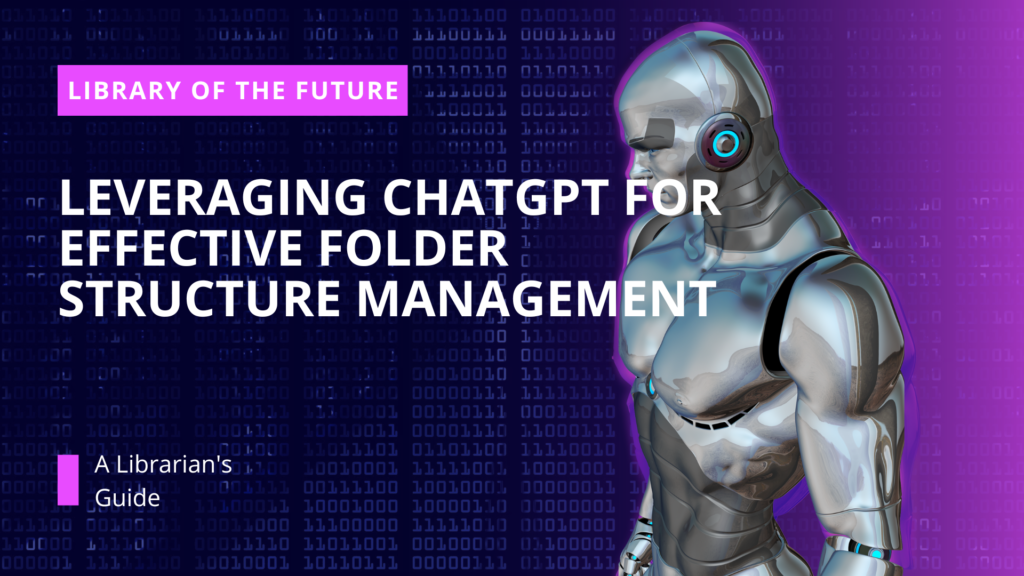Librarians face the challenge of managing and organising an ever-expanding collection of digital assets. With an overwhelming number of files in different formats and sizes, it’s easy to feel overwhelmed and lost in the chaos. Have no fear. Tok Mun will help you to conquer the chaos and take control of your digital assets like a real librarian.

Embracing AI in Digital Asset Management
Digital asset management is the process of storing, categorising, and retrieving digital files. It is a critical part of any librarian’s job, as it helps to ensure that files are easy to find and use.
This is where ChatGPT can help. ChatGPT is a powerful natural language processing (NLP) tool that generates text based on input. You can use ChatGPT to create folder names and descriptions that are relevant, informative, and concise. ChatGPT can also suggest alternative names and descriptions that suit your needs better.
Step 1: Define your main categories
The first step is to define your main categories of files. These are the top-level folders that will contain your subfolders and files. You can use broad terms that capture your files’ general theme or purpose. For example, if you have a collection of books on various topics, you can use the following main categories:
- Fiction
- Non-fiction
- Reference
To create these folders, you can type them in your file explorer or use ChatGPT to generate them for you. To use ChatGPT, you can enter a prompt such as “Generate three main categories for a library collection of books on various topics.” ChatGPT will then produce a list of possible folder names based on your prompt. For example:
- Literature
- Information
- Resources
You can choose the folder names that best suit your needs or modify them as you wish.
Step 2: Create subcategories
The next step is to create subcategories for each main category. These second-level folders will further divide your files into more specific groups. You can use more detailed terms that describe the subtopics or genres of your files. For example, if you have a fiction category, you can use the following subcategories:
- Fantasy
- Mystery
- Romance
- Science Fiction
To create these folders, you can type them in your file explorer or use ChatGPT to generate them. To use ChatGPT, you can enter a prompt such as “Generate four subcategories for fiction books.” ChatGPT will then produce a list of possible folder names based on your prompt. For example:
- Adventure
- Crime
- Historical
- Horror
You can choose the folder names that best suit your needs or modify them as you wish.
Bonus:
Here are some more examples of how ChatGPT can generate different folder names based on different prompts:
Generate four subcategories for non-fiction books.
- Biography
- History
- Science
- Self-help
Generate four subcategories for reference books.
- Dictionaries
- Encyclopedias
- Manuals
- Guides
Generate four subcategories for visual arts books.
- Painting
- Sculpture
- Photography
- Graphic Design
Step 3: Add descriptions
The final step is to add descriptions for each folder. These are short sentences that explain what each folder contains and why it is important. Descriptions can help you, and others understand the purpose and content of each folder at a glance. They can also help you avoid confusion and duplication of files.
To create these descriptions, you can type them in your file explorer or use ChatGPT to generate them. To use ChatGPT, you can enter a prompt such as “Generate a description for the fantasy subcategory.” ChatGPT will then produce a sentence based on your prompt. For example:
- Fantasy is a subcategory of fiction that features imaginative and magical elements such as wizards, dragons, and quests.
You can choose the description that best suits your needs or modify it as you wish.
Step 4: Review and improve
Once you have created your folder structure, you can review it and see if it meets your needs and expectations. You can also use ChatGPT to help you improve your folder structure by providing feedback and suggestions.
To use ChatGPT for this purpose, you can enter a prompt such as “Review my folder structure and suggest how to improve it.” ChatGPT will then analyze your folder structure and produce a list of possible improvements based on your prompt. For example:
- Consider adding more sub categories to non-fiction to cover more topics such as biography, history, science, etc.
- Consider renaming resources to references to avoid confusion with information.
- Consider adding more descriptions to explain the difference between literature and fiction.
- Consider using consistent capitalization and punctuation for all folder names and descriptions.
You can choose the improvements that best suit your needs or ignore them as you wish.
Final Thoughts
ChatGPT is a powerful tool to help you create and manage your folder structure effectively. By using ChatGPT, you can save time and effort in creating folder names and descriptions that are relevant, informative, and concise. You can also benefit from ChatGPT’s feedback and suggestions to improve your folder structure and make it more logical, consistent, and intuitive.
We hope this blog post has given you some insights into how to leverage ChatGPT for effective folder structure management.